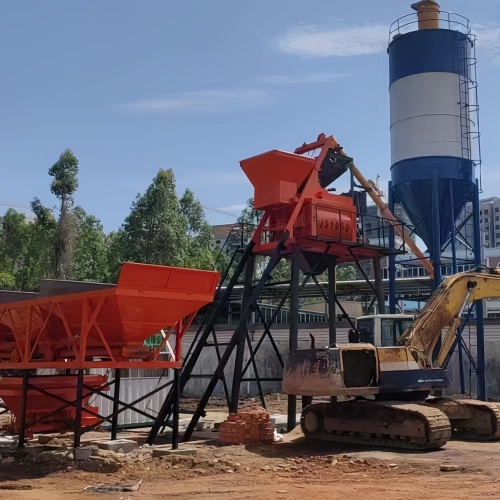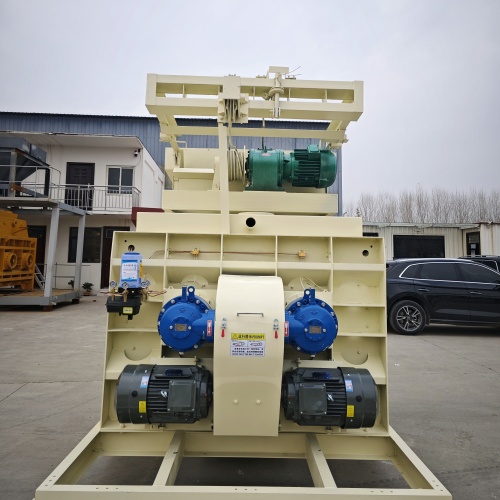In-depth Comparison between HZS50 and HZS60 Mixing Plants
I. Core Analysis of JS1000 Mixer Station Configuration
As the core host of small and medium-sized commercial concrete plants, the JS1000 mixer has a single mixing capacity of 1 cubic meter. Its supporting mixing plant models are primarily determined by the efficiency of the feeding system. According to international standard classifications, the JS1000 is mainly paired with two models:
• Hopper-type feeding system: Forms a standard HZS50 concrete mixing plant with a theoretical productivity of 50 m³/h.
• Belt-type feeding system: Forms an efficient HZS60 concrete mixing plant with a theoretical productivity of 60 m³/h.
This classification reflects the design philosophy of the concrete production equipment industry: "Same host, efficiency depends on the supporting system."

II. Detailed Comparative Analysis of Technical Parameters
Technical Specifications | HZS60 Mixing Plant (Belt Elevator)
| |
Main Unit Model | JS1000 Forced Mixer | |
Theoretical Cycles | 50 cycles/hour | 60 cycles/hour
|
Theoretical Output | 50m³/h | 60m³/h |
Actual Average Output | 40-45m³/h | 50-55m³/h |
Aggregate Storage System | No independent storage silo | standard 4 cubic meter aggregate buffer silo
|
Power Configuration | 90kW | 110kW |
III. In-depth Analysis of Feeding System Efficiency Mechanisms
3.1 Efficiency Bottlenecks of Hopper-Type Feeding
The HZS50 mixing plant uses a wire rope hoist system with inherent efficiency limitations:
Operation Cycle Analysis:
- Hopper loading time: 15-20 seconds
- Hoisting operation time: 10-15 seconds (speed: 0.8-1.2 m/s)
- Discharging time: 10 seconds
- Return descent time: 10-15 seconds
- Total cycle time: 70-90 seconds
Key Efficiency Loss Points:
- Mandatory waiting time accounts for 30%-40%
- Energy loss due to acceleration/deceleration
- Unutilized return time during empty operation
- Intermittent operation mode causes production fluctuations
3.2 Efficiency Advantages of Belt-Type Feeding
The HZS60 mixing plant’s belt conveyor system achieves revolutionary efficiency improvements:
Continuous Feeding Mechanism:
- Belt conveyor ensures continuous material transport
- Aggregates are pre-transported to the buffer hopper above the mixer
- The mixer operates without waiting for materials, enabling continuous production
- The buffer hopper acts as a "reservoir," balancing production efficiency
Key Technological Breakthroughs:
- Waiting hopper design: 4 m³ capacity ensures continuous feeding
- Constant speed operation: Reduces energy loss from frequent starts and stops
- Automated control: Precisely matches feeding and mixing times
- Easy maintenance: Belt systems have lower failure rates than hoist systems

IV. Investment Decision and Selection Guide
4.1 Applicable Scenarios Analysis
Situations for Choosing HZS50 Mixing Plant (Approx. 65% of Cases):
- Daily concrete demand below 300 m³
- Limited project budget, initial investment controlled at 300,000-400,000 RMB
- Project duration shorter than 12 months
- Limited installation space at the construction site
- Low production frequency requirements, intermittent production mode
Situations for Choosing HZS60 Mixing Plant (Approx. 35% of Cases):
- Daily concrete demand exceeds 300 m³
- Long-term continuous production projects, annual output exceeding 20,000 m³
- Sufficient site space for belt conveyor installation (length ≥ 45 meters)
- High requirements for production stability and efficiency
- Short payback period required for investment
4.2 Investment Return Analysis
Cost Difference Analysis:
- HZS60 equipment investment is approximately 100,000-200,000 RMB higher than HZS50
- Includes: Belt conveyor system, buffer hopper, reinforced structure
Payback Period Calculation:
Assuming a net profit of 30 RMB per cubic meter of concrete:
- Daily production advantage: HZS60 produces 50-70 m³ more per day than HZS50
- Daily revenue increase: 1,500-2,100 RMB/day
- Investment payback period: 200,000 RMB ÷ 1,800 RMB/day ≈ 111 days (approx. 4 months)
Long-Term Operational Benefits:
- Annual production increase benefit: Approximately 450,000 RMB (calculated based on 250 working days)
- Energy consumption reduction: Belt system saves 15%-20% energy compared to hoist system
- Labor cost reduction: Higher automation reduces 1-2 operators
V. Technical Upgrade and Retrofit Solutions
Existing HZS50 mixing plant users can improve production efficiency through technical upgrades:
Upgrade Option 1: Basic Retrofit
- Install belt conveyor to replace the hopper
- Add a 4 m³ aggregate buffer hopper
- Modify the electrical control system to match the new feeding method
- Investment cost: 80,000-120,000 RMB
Upgrade Option 2: Comprehensive Upgrade
- Replace with professional HZS60 batching system
- Upgrade the mixer host transmission system
- Optimize control system algorithms
- Investment cost: 60,000-100,000 RMB
Upgrade Effects:
- Production efficiency increased by 10%
- Energy consumption reduced
- Equipment reliability significantly improved
VI. Professional Selection Recommendations
Based on data analysis from hundreds of customer cases, we recommend:
Output-Oriented Choice:If your monthly production demand exceeds 8,000 m³, the HZS60 mixing plant is the ideal choice, as its efficiency advantages directly translate into economic benefits.
Investment-Cautious Choice:If the initial budget is limited or the project duration is short, the HZS50 offers a cost-effective solution that can be upgraded as business grows.
Sustainable Development Choice:Considering equipment residual value, the HZS60 mixing plant retains 10%-15% higher residual value after 3 years due to its technological advancedness.
Get a Free Personalized Solution:
Provide your specific requirements (aggregate type, daily production demand, site dimensions, investment budget), and our technical team will customize an optimized mixing plant configuration plan for you, including equipment selection, site planning, investment return analysis, and other complete solutions.